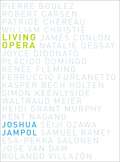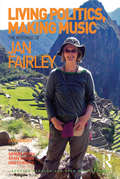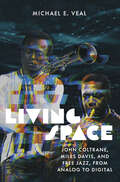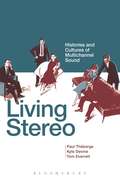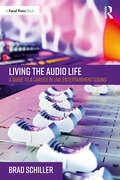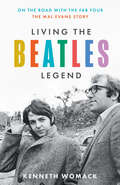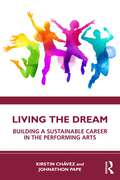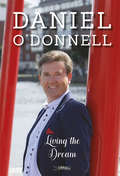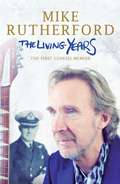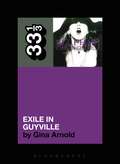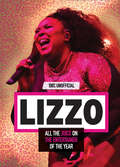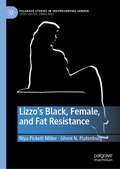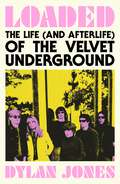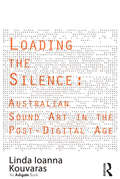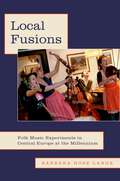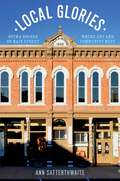- Table View
- List View
Living Opera
by Joshua JampolLiving Opera is a fascinating collection of 20 wide-ranging interviews with the preeminent opera professionals working on and behind the stage today. Joshua Jampol invites opera-lovers to listen in as performers such as Renee Fleming, Natalie Dessay, Rolando Villazon and Placido Domingo speak in exceptionally frank terms about their strengths and weaknesses, and address such hard-hitting, enduring topics as how they deal with critics, vocal troubles, and balancing their career and family lives. We hear conductors such as James Conlon, Esa-Pekka Salonen, and Kent Nagano discuss their likes and dislikes about the state of contemporary opera, their own inspirations, and whom they themselves hope to inspire. World-class directors such as Robert Carsen and Patrice Chéreau discuss the complexities involved in staging a successful opera, and how opera can remain relevant today. Jampol has unprecedented access to these major singers, conductors, and directors, and the table of contents reads like a "who's who" of the global opera world. Each interview highlights a distinctive voice, and Jampol brings immense knowledge and a wonderful flair to these conversations. He allows his subjects to follow their thoughts wherever they lead, and reveals in the process a more intimate, reflective side of the emotional and extravagant world of the lyric arts. For anyone wanting to know more about the people behind the performances--what they think, how they feel, and who they really are--Living Opera is full of delights and surprises.
Living Politics, Making Music: The Writings of Jan Fairley (Ashgate Popular and Folk Music Series)
by Jan Fairley edited by Frith Ian ChristieThe late Jan Fairley (1949-2012) was a key figure in making world music a significant topic for popular music studies and an influential contributor to such world music magazines as fRoots and Songlines. This book celebrates her contribution to popular music scholarship by gathering her most important work together in a single place. The result is a richly informed and entertaining volume that will be of interest to all scholars in the field while also serving as an excellent introduction for students interested in popular music as a global phenomenon. Fairley’s work was focused on the problems and possibilities of cross-cultural musical influences, fantasies and flows and on the importance of performing circuits and networks. Her interest in the details of music-making and in the lives of music-makers means that this collection is also an original and illuminating study of music and politics. In drawing on Jan Fairley’s journalism, this volume also offers students a guide to various genres of world music, from Cuban son to flamenco, as well as an insight into the lives of such world music stars as Mercedes Sosa and Silvio RodrÃguez. This is inspiring as well as essential reading.
Living Politics, Making Music: The Writings of Jan Fairley (Ashgate Popular and Folk Music Series)
by Jan Fairley edited by Frith Ian ChristieThe late Jan Fairley (1949-2012) was a key figure in making world music a significant topic for popular music studies and an influential contributor to such world music magazines as fRoots and Songlines. This book celebrates her contribution to popular music scholarship by gathering her most important work together in a single place. The result is a richly informed and entertaining volume that will be of interest to all scholars in the field while also serving as an excellent introduction for students interested in popular music as a global phenomenon. Fairley’s work was focused on the problems and possibilities of cross-cultural musical influences, fantasies and flows and on the importance of performing circuits and networks. Her interest in the details of music-making and in the lives of music-makers means that this collection is also an original and illuminating study of music and politics. In drawing on Jan Fairley’s journalism, this volume also offers students a guide to various genres of world music, from Cuban son to flamenco, as well as an insight into the lives of such world music stars as Mercedes Sosa and Silvio RodrÃguez. This is inspiring as well as essential reading.
Living Space: John Coltrane, Miles Davis, and Free Jazz, from Analog to Digital (Music / Culture)
by Michael E. VealLiving Space: John Coltrane, Miles Davis, and Free Jazz, from Analog to Digital fuses biography and style history in order to illuminate the music of two jazz icons, while drawing on the discourses of photography and digital architecture to fashion musical insights that may not be available through the traditional language of jazz analysis. The book follows the controversial trajectories of two jazz legends, emerging from the 1959 album Kind of Blue. Coltrane's odyssey through what became known as "free jazz" brought stylistic (r)evolution and chaos in equal measure. Davis's spearheading of "jazz-rock fusion" opened a door through which jazz's ongoing dialogue with the popular tradition could be regenerated, engaging both high and low ideas of creativity, community, and commerce. Includes 42 illustrations.
Living Stereo: Histories and Cultures of Multichannel Sound
by Kyle Devine Paul Théberge Tom EverrettStereo is everywhere. The whole culture and industry of music and sound became organized around the principle of stereophony during the twentieth century. But nothing about this-not the invention or acceptance or ubiquity of stereo-was inevitable. Nor did the aesthetic conventions, technological objects, and listening practices required to make sense of stereo emerge fully formed, out of the blue.This groundbreaking book uncovers the vast amount of work that has been required to make stereo seem natural, and which has been necessary to maintain stereo's place as a dominant mode of sound reproduction for over half a century. The essays contained within this book are thematically grouped under (Audio) Positions, Listening Cultures, and Multichannel Sound and Screen Media; the cumulative effect is to advance research in music, sound, and media studies and to build new bridges between the fields.With contributions from leading scholars across several disciplines, Living Stereo re-tells the history of twentieth-century aural and musical culture through the lens of stereophonic sound.
Living Stereo: Histories and Cultures of Multichannel Sound
by Kyle Devine Paul Théberge Tom EverrettStereo is everywhere. The whole culture and industry of music and sound became organized around the principle of stereophony during the twentieth century. But nothing about this-not the invention or acceptance or ubiquity of stereo-was inevitable. Nor did the aesthetic conventions, technological objects, and listening practices required to make sense of stereo emerge fully formed, out of the blue.This groundbreaking book uncovers the vast amount of work that has been required to make stereo seem natural, and which has been necessary to maintain stereo's place as a dominant mode of sound reproduction for over half a century. The essays contained within this book are thematically grouped under (Audio) Positions, Listening Cultures, and Multichannel Sound and Screen Media; the cumulative effect is to advance research in music, sound, and media studies and to build new bridges between the fields.With contributions from leading scholars across several disciplines, Living Stereo re-tells the history of twentieth-century aural and musical culture through the lens of stereophonic sound.
Living the Audio Life: A Guide to a Career in Live Entertainment Sound
by Brad SchillerLiving the Audio Life details the aspects and procedures necessary for one to have a successful career in live entertainment sound. Encompassing a wide range of topics, the text clearly guides anyone interested in working in a position within the live entertainment audio field. The guide is broken into clearly defined sections, allowing the reader to easily navigate through various subjects including jobs, career, business, creativity, lifestyle, and travel. Real-world examples and documentation from the author and key industry experts allow the reader to gain insight into the essential practices that are helpful throughout a career. Additional in-depth interviews provide details of careers from industry veterans. Whether considering a career in live entertainment audio or just starting out, readers will find the resources for the key to success in audio. Students, those new to sound, and workers already within their careers can refer to the text as a guide throughout their journeys. With benefits to anyone interested in the audio field, Living the Audio Life is a key navigational resource for success.
Living the Audio Life: A Guide to a Career in Live Entertainment Sound
by Brad SchillerLiving the Audio Life details the aspects and procedures necessary for one to have a successful career in live entertainment sound. Encompassing a wide range of topics, the text clearly guides anyone interested in working in a position within the live entertainment audio field. The guide is broken into clearly defined sections, allowing the reader to easily navigate through various subjects including jobs, career, business, creativity, lifestyle, and travel. Real-world examples and documentation from the author and key industry experts allow the reader to gain insight into the essential practices that are helpful throughout a career. Additional in-depth interviews provide details of careers from industry veterans. Whether considering a career in live entertainment audio or just starting out, readers will find the resources for the key to success in audio. Students, those new to sound, and workers already within their careers can refer to the text as a guide throughout their journeys. With benefits to anyone interested in the audio field, Living the Audio Life is a key navigational resource for success.
Living the Beatles Legend: On the Road with the Fab Four – The Mal Evans Story
by null Kenneth Womack**MiCannes Award Music Book of the Year** The first full-length biography of Mal Evans, the Beatles’ beloved roadie, assistant, confidant and friend A towering figure in horn-rimmed glasses, Malcolm ‘Mal’ Evans was an invaluable member of the Beatles’ inner circle. Serving as their long-time roadie, personal assistant and protector, he was a sometime lyricist, occasional performer and regular fixer at the height of the group’s fame and beyond. But Mal’s dedication to his beloved ‘boys’ and his own desire for stardom took its toll, leading to the dissolution of his marriage and his untimely death in January 1976. Until now, Mal’s extraordinary life has remained shrouded in mystery. Drawing on hundreds of exclusive interviews and with full access to Mal’s unpublished archives – including his personal diaries, manuscripts and memorabilia – renowned Beatles scholar Kenneth Womack paints the first complete portrait of this complicated figure at the heart of the Beatles’ story. Living the Beatles Legend is a fascinating but ultimately tragic tale about life at the edges of superstardom.
Living the Dream: Building a Sustainable Career in the Performing Arts
by Kirstin Chávez Johnathon PapeLiving the Dream: Building a Sustainable Career in the Performing Arts offers an accessible guide to understanding one’s arts career as a business. This essential companion to the inner workings of the arts world begins with defining the dream, including how to conceive mission statements, branding and business plans. Part II covers sharing the dream with others through social media, networking, and working with agents or artist managers. Part III offers an overview of the financial aspect, including budgets, taxes, and managing risks. Part IV concludes by discussing the realities of an arts career, including work/life balance, preparing for the future, and managing mental health. This practical and insightful overview is a must‑have companion for aspiring and early career professionals in the performing arts, as well as students on a range of arts courses, including Music Business, Entrepreneurship, and Career Skills classes.
Living the Dream: Building a Sustainable Career in the Performing Arts
by Kirstin Chávez Johnathon PapeLiving the Dream: Building a Sustainable Career in the Performing Arts offers an accessible guide to understanding one’s arts career as a business. This essential companion to the inner workings of the arts world begins with defining the dream, including how to conceive mission statements, branding and business plans. Part II covers sharing the dream with others through social media, networking, and working with agents or artist managers. Part III offers an overview of the financial aspect, including budgets, taxes, and managing risks. Part IV concludes by discussing the realities of an arts career, including work/life balance, preparing for the future, and managing mental health. This practical and insightful overview is a must‑have companion for aspiring and early career professionals in the performing arts, as well as students on a range of arts courses, including Music Business, Entrepreneurship, and Career Skills classes.
Living the Dream
by Daniel O'DonnellIn Ireland, Daniel O’Donnell is more than just a singing star: he has reached the status of 'national treasure'. It has been a long journey for the boy from Kincasslagh, County Donegal, and in Living the Dream he tells his story with his customary sense of humour and down-to-earth charm. Much has happened in Daniel O’Donnell’s life since his first autobiography, Follow Your Dream, and in this new book he reflects on the range of experiences and emotions that accompanied his wife Majella’s battle with cancer; the death of his beloved mother, Julia; his part in the BBC’s Strictly Come Dancing TV show; and his B&B Road Trip adventures with Majella. And he delves into the relentless touring and recording that took him to the brink of burnout and forced him to reassess his priorities. Daniel O’Donnell is an international phenomenon – ‘a real star’. His fans will love this latest instalment of his extraordinary life story.
Living Well with Dementia through Music: A Resource Book for Activities Providers and Care Staff
by Sarah Metcalfe Nigel Marshall Ruth Melhuish Alison Acton Clare Barone Arash Bazrafshan Melanie Burton Evan Dawson Melissa Elliott Maggie Grady Tobias Kaye Nicola Jacobson-Wright Harriet Powell Trish Vella-Burrows Ian SpinkMusic is an essential tool in dementia care. This accessible guide embraces ways in which music can enhance the daily lives of those with dementia. It draws on the expertise of practitioners regularly working in dementia settings, as well as incorporating research on people with dementia, to help anyone, whether or not they have any musical skills or experience, to successfully use music in dementia care.Guiding the reader through accessible activities with singing, percussion, sounding bowls and other musical tools, the book shows how music may can be used from the early to late stages of dementia. This creative outlet can extend to inspire dance, movement, poetry and imagery. The chapters include creative uses of technology, such as tablets and personal playlists.The book also covers general considerations for using music with people living with dementia in institutional settings, including evaluating and recording outcomes.Living Well with Dementia through Music is the perfect go-to guide for music-based activities with people living with dementia.
The Living Years: The First Genesis Memoir (Tom Thorne Novels #414)
by Mike Rutherford"Now Michael, you're the son of a naval officer, you must behave like a naval officer at all times..."What Captain William Rutherford told his seven-year-old son Michael was to stay with him all his life. Born in 1950, Michael was truly his father's son, even serving in the naval section of the student cadet corps at one of England's top public schools, Charterhouse. Mike's future lay in the civil service: it was a subject that he discussed with his father at Captain Crawford's gentlemen's club. But then something happened. Mike discovered rock music. As one of the founder members of Genesis, Mike was to tour the world and achieve international fame. From unpromising beginnings - demonised by his teachers as a fomenter of revolution, driving to gigs in a bread van - Mike would go on to crisscross the globe with bandmates Peter Gabriel and, later, Phil Collins, playing to packed-out stadiums and achieving record sales of over 150 million. Swapping old school ties and Savile Row suits for flares and Afghan coats, Mike and Genesis would pioneer the pomp and theatricality of 1970s progressive rock before becoming household names in the 1980s with hits like Turn It On Again, Mama and Land of Confusion. There was drink, there were drugs; there were arguments and excess. But, in the background - and sometimes in the audience - there was also the loyal Captain Rutherford, earplugs at the ready, Melody Maker in hand. A proud father still.The Living Years spans the entire history of Genesis, from the earliest days as a school band to the triumphant 2007 reunion tour when Genesis played to over 500,000 people in Rome. But this is not just another rock 'n' roll memoir. This is also a book about two men whose lives and complex relationship reflect the seismic social and cultural shifts that took place during the twentieth century. A book for every father and son.
Liz Phair's Exile in Guyville (33 1/3)
by Gina ArnoldAlthough Exile in Guyville was celebrated as one of the year's top records by Spin and the New York Times, it was also, to some, an abomination: a mockery of the Rolling Stones' most revered record and a rare glimpse into the psyche of a shrewd, independent, strong young woman. For these crimes, Liz Phair was run out of her hometown of Chicago, enduring a flame war perpetrated by writers who accused her of being boring, inauthentic, and even a poor musician. With Exile in Guyville, Phair spoke for all the girls who loved the world of indie rock but felt deeply unwelcome there. Like all great works of art, Exile was a harbinger of the shape of things to come: Phair may have undermined the male ego, but she also unleashed a new female one. For the sake of all the female artists who have benefited from her work-from Sleater-Kinney to Lana Del Rey and back again-it's high time we go back to Guyville.
Liz Phair's Exile in Guyville (33 1/3)
by Gina ArnoldAlthough Exile in Guyville was celebrated as one of the year's top records by Spin and the New York Times, it was also, to some, an abomination: a mockery of the Rolling Stones' most revered record and a rare glimpse into the psyche of a shrewd, independent, strong young woman. For these crimes, Liz Phair was run out of her hometown of Chicago, enduring a flame war perpetrated by writers who accused her of being boring, inauthentic, and even a poor musician. With Exile in Guyville, Phair spoke for all the girls who loved the world of indie rock but felt deeply unwelcome there. Like all great works of art, Exile was a harbinger of the shape of things to come: Phair may have undermined the male ego, but she also unleashed a new female one. For the sake of all the female artists who have benefited from her work-from Sleater-Kinney to Lana Del Rey and back again-it's high time we go back to Guyville.
Lizzo: 100% Unofficial – All the Juice on the Entertainer of the Year
by Natasha MulengaLizzo is the flute-playing, fiercely positive, entertainer of the decade!
Lizzo’s Black, Female, and Fat Resistance (Palgrave Studies in (Re)Presenting Gender)
by Niya Pickett Miller Gheni N. PlatenburgCelebrated musician and entertainer Lizzo wowed audiences and left many “feeling good as hell.” Notwithstanding her collective—fat, Black female— identity she catapulted into mainstream success while redefining the social script for body size, race, and gender. This book explores a tale of two narratives: Lizzo’s self-curated, fat-positive identity and the media’s reaction to an unabashedly proud fat, Black woman. This critical analysis examines how Lizzo challenges fatphobia and reconstitutes fat stigmatization into self-empowerment through her strategic use of hyper-embodiment via social media, and the rhetorical distinctions between Lizzo’s self-curated narrative via social media and those offered about her in print media. In part, Lizzo’s bodily flaunting is argued as a significant rhetorical act that emancipates her identity of fatness and reframes the negative tropes of (fat) Black women typically curated in American culture.
Loaded: The Life (and Afterlife) of The Velvet Underground
by Dylan JonesRebellion always starts somewhere, and in the music world of the transgressive teen whether it be the 1960s of the 2020s, The Velvet Underground represent ground zero. Crystallizing the idea of the bohemian, urban, narcissistic art school gang, around a psychedelic rock and roll band - a stylistic idea that evolved in the rarefied environs of Andy Warhol's Factory - The Velvets were the first major American rock group with a mixed gender line-up; they never smiled in photographs, wore sunglasses indoors, and in the process invented the archetype. They were avant-garde nihilists, writing about drug abuse, prostitution, paranoia, and sado-masochistic sex at a time when the rest of the world was singing about peace and love. Dylan Jones' definitive oral history of The Velvet Underground draws on contributions from remaining members, contemporaneous musicians, critics, film-makers, and the generation of artists who emerged in their wake, to celebrate not only their impact but their legacy, which burns brighter than ever into the 21st century.
Loading the Silence: Australian Sound Art in the Post-Digital Age
by Linda Ioanna KouvarasThe experimentalist phenomenon of 'noise' as constituting 'art' in much twentieth-century music (paradoxically) reached its zenith in Cage’s (’silent’ piece) 4’33 . But much post-1970s musical endeavour with an experimentalist telos, collectively known as 'sound art', has displayed a postmodern need to ’load’ modernism’s ’degree zero’. After contextualizing experimentalism from its inception in the early twentieth century, Dr Linda Kouvaras’s Loading the Silence: Australian Sound Art in the Post-Digital Age explores the ways in which selected sound art works demonstrate creatively how sound is embedded within local, national, gendered and historical environments. Taking Australian music as its primary - but not sole - focus, the book not only covers discussions of technological advancement, but also engages with aesthetic standpoints, through numerous interviews, theoretical developments, analysis and cultural milieux for a contemporary Australian, and wider postmodern, context. Developing new methodologies for synergies between musicology and cultural studies, the book uncovers a new post-postmodern aesthetic trajectory, which Kouvaras locates as developing over the past two decades - the altermodern. Australian sound art is here put firmly on the map of international debates about contemporary music, providing a standard reference and valuable resource for practitioners in the artform, music critics, scholars and educators.
Loading the Silence: Australian Sound Art in the Post-Digital Age
by Linda Ioanna KouvarasThe experimentalist phenomenon of 'noise' as constituting 'art' in much twentieth-century music (paradoxically) reached its zenith in Cage’s (’silent’ piece) 4’33 . But much post-1970s musical endeavour with an experimentalist telos, collectively known as 'sound art', has displayed a postmodern need to ’load’ modernism’s ’degree zero’. After contextualizing experimentalism from its inception in the early twentieth century, Dr Linda Kouvaras’s Loading the Silence: Australian Sound Art in the Post-Digital Age explores the ways in which selected sound art works demonstrate creatively how sound is embedded within local, national, gendered and historical environments. Taking Australian music as its primary - but not sole - focus, the book not only covers discussions of technological advancement, but also engages with aesthetic standpoints, through numerous interviews, theoretical developments, analysis and cultural milieux for a contemporary Australian, and wider postmodern, context. Developing new methodologies for synergies between musicology and cultural studies, the book uncovers a new post-postmodern aesthetic trajectory, which Kouvaras locates as developing over the past two decades - the altermodern. Australian sound art is here put firmly on the map of international debates about contemporary music, providing a standard reference and valuable resource for practitioners in the artform, music critics, scholars and educators.
Local Fusions: Folk Music Experiments in Central Europe at the Millennium
by Barbara Rose LangeIn Local Fusions, author Barbara Rose Lange explores musical life in Hungary, Slovakia, and Austria between the end of the Cold War and the world financial crisis of 2008. With case studies from Budapest, Bratislava, and Vienna, the book looks at the ways that artists generated social commentary and tried new ways of working together as the political and economic atmosphere shifted during this time. Drawn from a variety of sources, the case studies illustrate how young musicians redefined a Central European history of elevating the arts by fusing poetry, local folk music, and other vernacular music with jazz, Asian music, art music, and electronic dance music. Their projects rejected exclusion based on ethnic background or gender prevalent in Central Europe's present far-right political movements, and instead embraced diverse modes of expression. Through this, the musicians asserted woman power, broadened masculinities, and declared affinity with regional minorities such as the Romani people.
LOCAL FUSIONS C: Folk Music Experiments in Central Europe at the Millennium
by Barbara Rose LangeIn Local Fusions, author Barbara Rose Lange explores musical life in Hungary, Slovakia, and Austria between the end of the Cold War and the world financial crisis of 2008. With case studies from Budapest, Bratislava, and Vienna, the book looks at the ways that artists generated social commentary and tried new ways of working together as the political and economic atmosphere shifted during this time. Drawn from a variety of sources, the case studies illustrate how young musicians redefined a Central European history of elevating the arts by fusing poetry, local folk music, and other vernacular music with jazz, Asian music, art music, and electronic dance music. Their projects rejected exclusion based on ethnic background or gender prevalent in Central Europe's present far-right political movements, and instead embraced diverse modes of expression. Through this, the musicians asserted woman power, broadened masculinities, and declared affinity with regional minorities such as the Romani people.
Local Glories: Opera Houses on Main Street, Where Art and Community Meet
by Ann SatterthwaiteTo most people, the term "opera house" conjures up images of mink-coated dowagers accompanied by tuxedo-clad men in the gilded interiors of opulent buildings like the Met in New York or La Scala in Milan. However, the opera house in the United States has a far more varied-and far more interesting-history than that stereotype implies. In Local Glories, Ann Satterthwaite explores the creative, social, and communal roles of the thousands of opera houses that flourished in small towns across the country. By 1900, opera houses were everywhere: on second floors over hardware stores, in grand independent buildings, in the back rooms of New England town halls, and even in the bowels of a Mississippi department store. With travel made easier by the newly expanded rail lines, Sarah Bernhardt, Mark Twain, and John Philip Sousa entertained thousands of townspeople, as did countless actors, theater and opera companies, innumerable minor league magicians, circuses, and lecturers, and even 500 troupes that performed nothing but Uncle Tom's Cabin. Often the town's only large space for public assembly, the local opera house served as a place for local activities such as school graduations, recitations, sports, town meetings, elections, political rallies, and even social dances and roller skating parties. Considered local landmarks, often in distinctive architect-designed buildings, they aroused considerable pride and reinforced town identity. By considering states with distinctly different histories--principally Maine, Nebraska, Vermont, New York, and Colorado--Satterthwaite describes the diversity of opera houses, programs, audiences, buildings, promoters, and supporters--and their hopes, dreams, and ambitions. In the twentieth century, radio and movies, and later television and changing tastes made these opera houses seem obsolete. Some were demolished, while others languished for decades until stalwart revivers discovered them again in the 1970s. The resuscitation of these opera houses today, an example of historic preservation and creative reuse, reflects the timeless quest for cultural inspiration and for local engagement to counter the anonymity of the larger world. These "local glories" are where art and community meet, forging connections and making communities today, just as they did in the nineteenth century.
